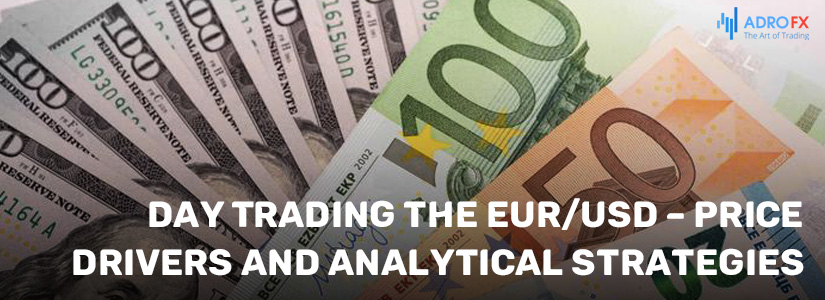Unlocking the Potential: Day Trading the EUR/USD – Price Drivers and Analytical Strategies

In the dynamic world of financial markets, day trading stands as a testament to the ever-evolving landscape of investment opportunities. Among the multitude of trading instruments available to traders, the EUR/USD currency pair stands out as a perennial favorite. Renowned for its liquidity, volatility, and global economic significance, the EUR/USD pair presents a compelling canvas for day traders seeking to capitalize on short-term price movements.
This article embarks on a journey to explore the intricate nuances of day trading the EUR/USD. From deciphering the driving forces behind price fluctuations to unraveling analytical techniques that empower traders with foresight, we delve into the heart of this exciting venture. Whether you're an experienced trader looking to refine your strategies or a newcomer eager to step into the world of forex day trading, our comprehensive guide will provide invaluable insights and practical tips to help you navigate the exciting world of day trading the EUR/USD. Join us as we uncover the strategies, tools, and market dynamics that can lead to success in this dynamic arena.
What Is the EUR/USD Currency Pair?
The EUR/USD, a widely recognized abbreviation for the euro versus the US dollar, is often affectionately referred to as "the Fiber" within trading circles. This particular currency pair holds a distinguished status in the global financial arena, primarily due to the close economic relationship between the United States and the European Union. Consequently, it has earned its place as the most popular and actively traded currency pair worldwide.
Notably, both the euro and the US dollar are preeminent players in the international currency market, with daily transactions collectively amounting to trillions of dollars. The historical narrative of the EUR/USD is a rich tapestry that began unfolding in 1999, coinciding with the adoption of a single currency across European Union member countries. During this period, countries such as France, Germany, and Italy relinquished their national currencies, marking a significant milestone in the pair's evolutionary journey.
What Factors Drive the EUR/USD?
Understanding the intricate dynamics governing the EUR/USD is pivotal for traders aiming to navigate its volatile waters effectively, especially over the medium and long-term horizons.
Federal Reserve and European Central Bank (ECB)
The most influential driver behind the EUR/USD is the interest rate decisions made by two formidable financial institutions: the European Central Bank (ECB) and the Federal Reserve. These central banks convene approximately eight times a year to assess economic conditions and fine-tune monetary policies. As two of the world's most powerful central banks, boasting assets in the trillions, their pronouncements reverberate across financial markets.
Market sentiment closely tracks data releases from both the United States and the Eurozone, particularly focusing on how these releases might influence the decisions of the ECB and Federal Reserve. For instance, robust employment and inflation figures released by the US invariably trigger speculation about the ensuing policy adjustments by these central banks. A shift towards a more hawkish stance by the Federal Reserve, compared to the ECB, can lead to a significant decline in the EUR/USD, as was evident in the sharp drop in November 2021:

Geopolitical Factors
The EUR/USD is sensitive to major geopolitical events occurring globally. In times of heightened global risk, the pair often retreats, mainly because the US dollar is frequently perceived as a safe-haven currency. Events like Brexit, US-China tensions, and trade disputes initiated by former US President Donald Trump with Europe have all exerted downward pressure on the pair in the past.
Economic Data
Several key economic indicators have a profound impact on the EUR/USD:
- Non-farm Payroll: Published by the US on the first Friday of each month, this employment report can significantly influence the pair's movement. Strong job figures often lead to a drop in the EUR/USD, signaling potential Federal Reserve tightening.
- Inflation: Monthly inflation data releases in both the US and Eurozone play a pivotal role. Robust US inflation data tends to push the EUR/USD lower, as it hints at a more hawkish Federal Reserve.
- Retail Sales: As a major driver of employment and a key indicator of consumer spending, retail sales data in the US and Europe offer crucial insights into economic health.
- Manufacturing and Services PMIs, Industrial Production, and Consumer Confidence are additional essential metrics that sway the EUR/USD as they provide a snapshot of economic performance and sentiment.
Strategies to Trade the EUR/USD
Trading the EUR/USD (Euro/US Dollar) currency pair is one of the most popular activities in the forex market. To be successful, traders typically use various strategies and techniques. Here are some common strategies for trading EUR/USD:
Technical Analysis
Many traders use technical analysis to make trading decisions. This involves studying price charts, identifying patterns (e.g., head and shoulders, double tops/bottoms), and using technical indicators (e.g., moving averages, RSI, MACD) to predict future price movements. Technical analysis helps traders determine entry and exit points.
Fundamental Analysis
Fundamental analysis involves analyzing economic and political factors that can influence the EUR/USD exchange rate. This includes monitoring economic data such as GDP growth, employment figures, inflation rates, and central bank policies. News releases and events, such as interest rate decisions, can have a significant impact on the currency pair.
Trend Following
Trend-following strategies involve identifying and trading in the direction of the prevailing trend. Traders look for signs of a strong uptrend or downtrend and enter positions accordingly. Stop-loss orders are often used to manage risk.
Range Trading
Range trading involves identifying periods when the EUR/USD is trading within a defined price range. Traders aim to buy near support levels and sell near resistance levels. This strategy can be effective in sideways or consolidating markets.
Scalping
Scalping is a short-term trading strategy where traders aim to profit from small price movements within minutes or seconds. Scalpers often make numerous small trades in a single day, aiming to accumulate profits over time.
Swing Trading
Swing traders look to capture larger price movements by holding positions for several days or even weeks. They analyze both technical and fundamental factors to identify potential swing points.
Carry Trade
The carry trade strategy involves borrowing funds in a currency with a low interest rate (e.g., the USD) and investing them in a currency with a higher interest rate (e.g., the EUR). Traders aim to profit from the interest rate differential.
Hedging
Traders may use EUR/USD as part of a hedging strategy to protect against currency risk in other investments. For example, a company with exposure to EUR might use EUR/USD positions to offset potential losses.
Remember that there is no one-size-fits-all strategy for trading the EUR/USD. Different traders have different risk tolerances and time horizons, so it's essential to choose a strategy that aligns with your goals and preferences. Additionally, always stay informed about the risks involved in forex trading and consider seeking advice from financial professionals. 
Tips for Trading EUR/USD
Trading the EUR/USD currency pair can be both rewarding and challenging. To increase your chances of success, consider these tips:
- Lay the Foundation with Education
Before venturing into EUR/USD trading, invest your time in acquiring knowledge. Learn about the complexities of the forex market, gain insights into the factors steering the EUR/USD pair, and acquaint yourself with a range of trading strategies and tools. - Blueprint Your Trading Journey
Forge a well-structured trading plan that acts as your guiding compass. Detail your objectives, establish your risk tolerance, outline your entry and exit strategies, and define your position sizing criteria. A robust plan will act as a stalwart ally in preserving discipline and averting impulsive decisions. - Master the Art of Risk Management
Never underestimate the power of proper risk management. Safeguard your capital by implementing stop-loss orders, which act as your financial safety net. Remember, never expose more capital than you can comfortably afford to part with. - Initiate with a Demo Detour
For those stepping into the world of forex trading, consider commencing your journey with a demo account. This risk-free environment allows you to practice your trading strategies without the burden of real capital at stake. It's the ideal playground for building both experience and confidence. - Stay In the Know
Keep your finger on the pulse of market events. Regularly consult economic calendars, monitor breaking news, and remain vigilant about developments that can sway the EUR/USD exchange rate. Be particularly attentive to announcements from central banks, economic reports, and geopolitical occurrences. - Broker Selection Matters
Choosing the right forex broker is akin to selecting a reliable vehicle for a long journey. Opt for a reputable broker offering competitive spreads, swift execution speeds, and an intuitive trading platform. Conduct thorough research and read reviews to make an informed decision. - Leverage with Care
Leverage can magnify both profits and losses, so tread cautiously, especially if you're a novice trader. It's often prudent to start with low leverage or even abstain from it until you've accumulated more experience. - Trade When the Market is Alive
Timing is crucial in EUR/USD trading. Focus your efforts during the overlapping European and U.S. trading sessions when market liquidity is at its peak, and price movements tend to be more predictable. - Steer Clear of Overtrading Pitfalls
Resist the temptation to overtrade. Trading too frequently or risking substantial capital on a single transaction can lead to exhaustion and emotional strain. Maintain a disciplined approach to trading frequency and position size. - Emotions
The Double-Edged Sword: Fear and greed can be formidable foes. Remain vigilant and adhere to your trading plan. Discipline is your armor against impulsive decisions driven by emotions. - Blend Technical and Fundamental Insights
Fuse the powers of both technical and fundamental analysis. While technical analysis helps pinpoint entry and exit timings, fundamental analysis provides you with a broader context of the market's movements. - Put Strategies to the Test
Before deploying a new trading strategy in the live market, subject it to rigorous backtesting on historical data. This will unveil the strategy's strengths and weaknesses and enhance your confidence in its efficacy. - Embrace Continuous Learning
Forex markets are ever-evolving. Stay receptive to new information, trading techniques, and evolving market conditions. A growth mindset is your ally in this dynamic landscape. - Diversify for Resilience
Consider broadening your trading portfolio by exploring multiple currency pairs or other asset classes. Diversification helps spread risk and can enhance your resilience to market fluctuations. - Evolve and Adapt
Regularly review your trading performance. Adjust your strategies as needed based on lessons learned from both your successes and losses. Adaptability is a hallmark of successful traders.
Always bear in mind that trading the EUR/USD carries inherent risks, and no guarantees of profits exist. Approach your trading endeavors with prudence, discipline, and a realistic outlook. If you're new to the game, seeking guidance from experienced traders or financial professionals is a wise step, and never venture into trading with funds you cannot afford to lose.
Conclusion
In conclusion, day trading the EUR/USD currency pair offers an enticing opportunity within the ever-evolving world of financial markets. This dynamic duo, characterized by its liquidity, volatility, and global significance, beckons traders with the promise of capitalizing on short-term price movements.
As you embark on your own trading journey in the EUR/USD market, remember the importance of education, discipline, and risk management. Success in day trading requires continuous learning, adaptability, and a vigilant eye on market developments. Always trade responsibly, stay informed, and be prepared for the challenges and opportunities that this dynamic market offers. Day trading the EUR/USD is a thrilling endeavor, and with the right knowledge and approach, you can unlock its potential and navigate its exciting twists and turns.

About AdroFx
Established in 2018, AdroFx is known for its high technology and its ability to deliver high-quality brokerage services in more than 200 countries around the world. AdroFx makes every effort to keep its customers satisfied and to meet all the trading needs of any trader. With the five types of trading accounts, we have all it takes to fit any traders` needs and styles. The company provides access to 115+ trading instruments, including currencies, metals, stocks, and cryptocurrencies, which make it possible to make the most out of trading on the financial markets. Considering all the above, AdroFx is the perfect variant for anyone who doesn't settle for less than the best









